Business Economics Report: Australian Economic Stability
VerifiedAdded on 2020/02/19
|10
|1335
|115
Report
AI Summary
This report delves into the concept of stable economic equilibrium, explaining it through demand and supply dynamics, both at a microeconomic and macroeconomic level. It examines the Australian economy, a market capitalist system, assessing its stability using macroeconomic indicators like GDP growth and inflation rates. The report highlights the role of government intervention, specifically automatic and discretionary stabilizers, in maintaining economic stability during business cycle fluctuations. The analysis provides a comprehensive understanding of how equilibrium is achieved and sustained within the Australian economic context, offering valuable insights into the interplay of market forces and governmental policies.
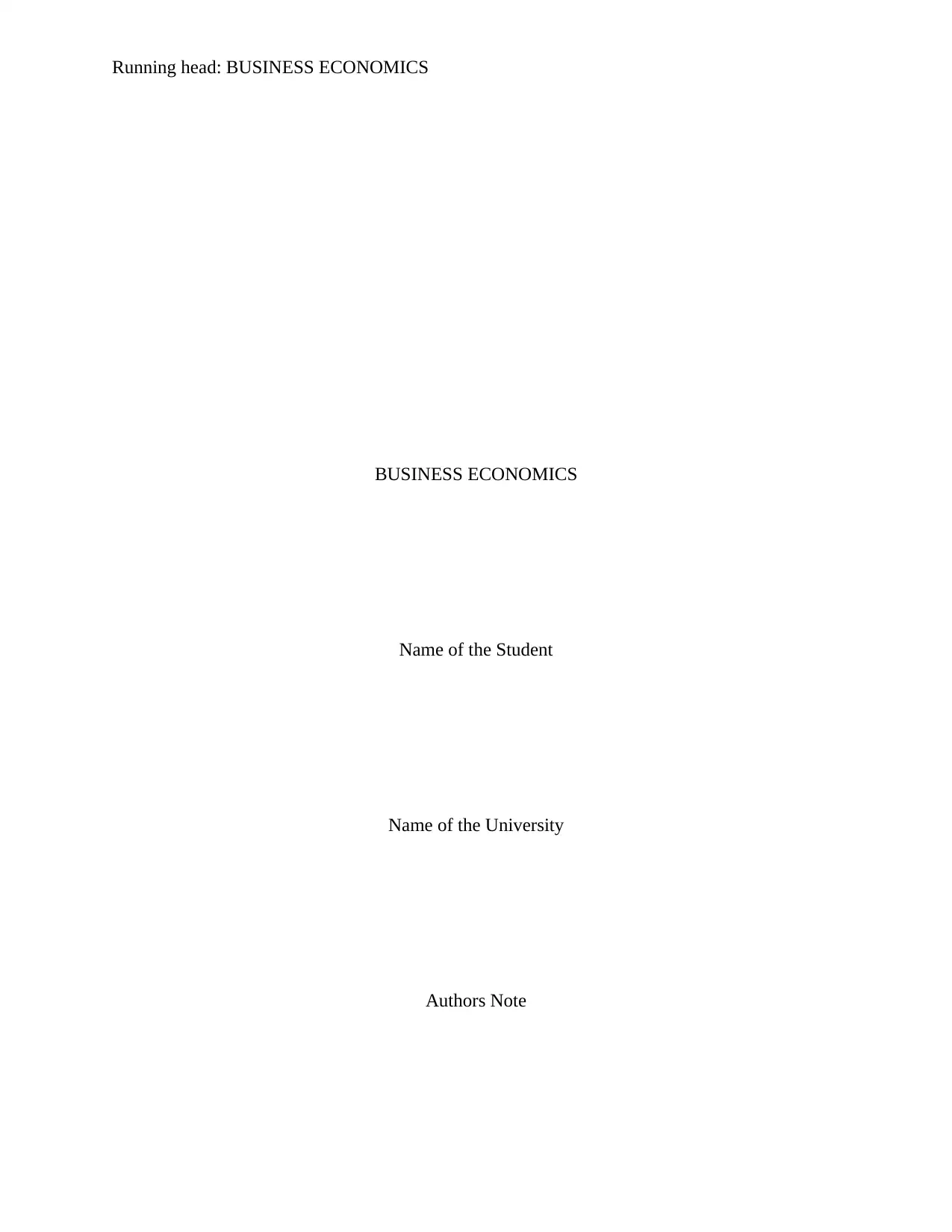
Running head: BUSINESS ECONOMICS
BUSINESS ECONOMICS
Name of the Student
Name of the University
Authors Note
BUSINESS ECONOMICS
Name of the Student
Name of the University
Authors Note
Paraphrase This Document
Need a fresh take? Get an instant paraphrase of this document with our AI Paraphraser
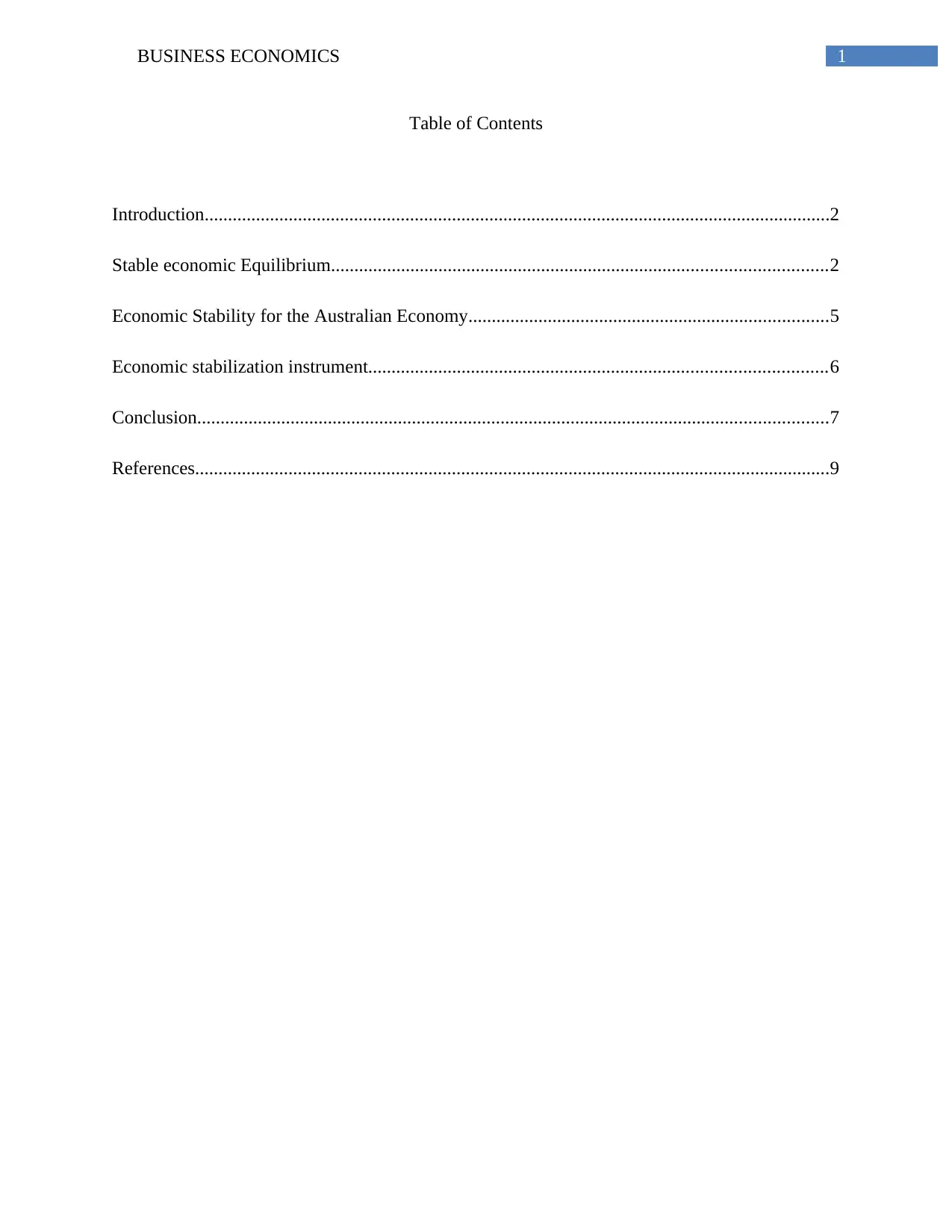
1BUSINESS ECONOMICS
Table of Contents
Introduction......................................................................................................................................2
Stable economic Equilibrium..........................................................................................................2
Economic Stability for the Australian Economy.............................................................................5
Economic stabilization instrument..................................................................................................6
Conclusion.......................................................................................................................................7
References........................................................................................................................................9
Table of Contents
Introduction......................................................................................................................................2
Stable economic Equilibrium..........................................................................................................2
Economic Stability for the Australian Economy.............................................................................5
Economic stabilization instrument..................................................................................................6
Conclusion.......................................................................................................................................7
References........................................................................................................................................9
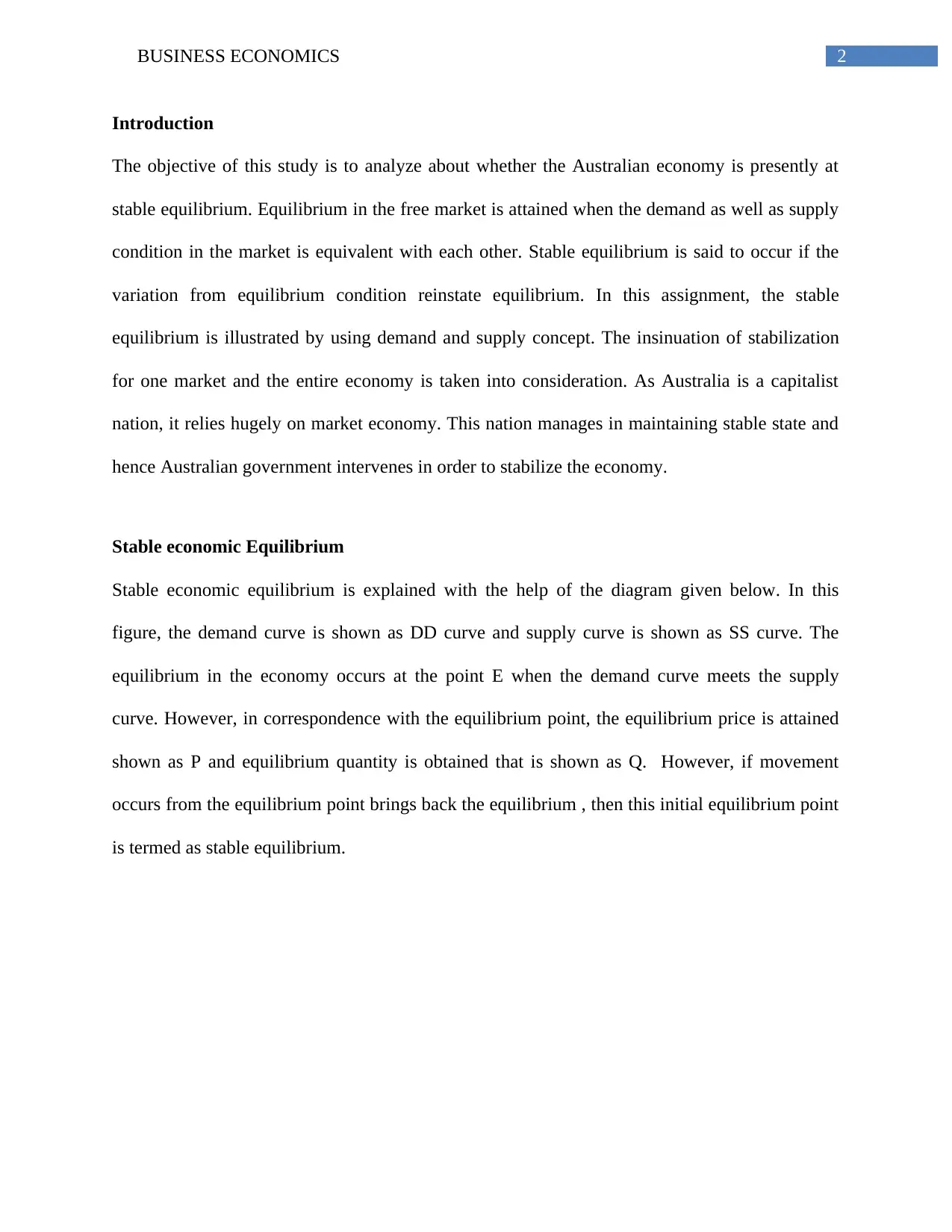
2BUSINESS ECONOMICS
Introduction
The objective of this study is to analyze about whether the Australian economy is presently at
stable equilibrium. Equilibrium in the free market is attained when the demand as well as supply
condition in the market is equivalent with each other. Stable equilibrium is said to occur if the
variation from equilibrium condition reinstate equilibrium. In this assignment, the stable
equilibrium is illustrated by using demand and supply concept. The insinuation of stabilization
for one market and the entire economy is taken into consideration. As Australia is a capitalist
nation, it relies hugely on market economy. This nation manages in maintaining stable state and
hence Australian government intervenes in order to stabilize the economy.
Stable economic Equilibrium
Stable economic equilibrium is explained with the help of the diagram given below. In this
figure, the demand curve is shown as DD curve and supply curve is shown as SS curve. The
equilibrium in the economy occurs at the point E when the demand curve meets the supply
curve. However, in correspondence with the equilibrium point, the equilibrium price is attained
shown as P and equilibrium quantity is obtained that is shown as Q. However, if movement
occurs from the equilibrium point brings back the equilibrium , then this initial equilibrium point
is termed as stable equilibrium.
Introduction
The objective of this study is to analyze about whether the Australian economy is presently at
stable equilibrium. Equilibrium in the free market is attained when the demand as well as supply
condition in the market is equivalent with each other. Stable equilibrium is said to occur if the
variation from equilibrium condition reinstate equilibrium. In this assignment, the stable
equilibrium is illustrated by using demand and supply concept. The insinuation of stabilization
for one market and the entire economy is taken into consideration. As Australia is a capitalist
nation, it relies hugely on market economy. This nation manages in maintaining stable state and
hence Australian government intervenes in order to stabilize the economy.
Stable economic Equilibrium
Stable economic equilibrium is explained with the help of the diagram given below. In this
figure, the demand curve is shown as DD curve and supply curve is shown as SS curve. The
equilibrium in the economy occurs at the point E when the demand curve meets the supply
curve. However, in correspondence with the equilibrium point, the equilibrium price is attained
shown as P and equilibrium quantity is obtained that is shown as Q. However, if movement
occurs from the equilibrium point brings back the equilibrium , then this initial equilibrium point
is termed as stable equilibrium.
⊘ This is a preview!⊘
Do you want full access?
Subscribe today to unlock all pages.

Trusted by 1+ million students worldwide
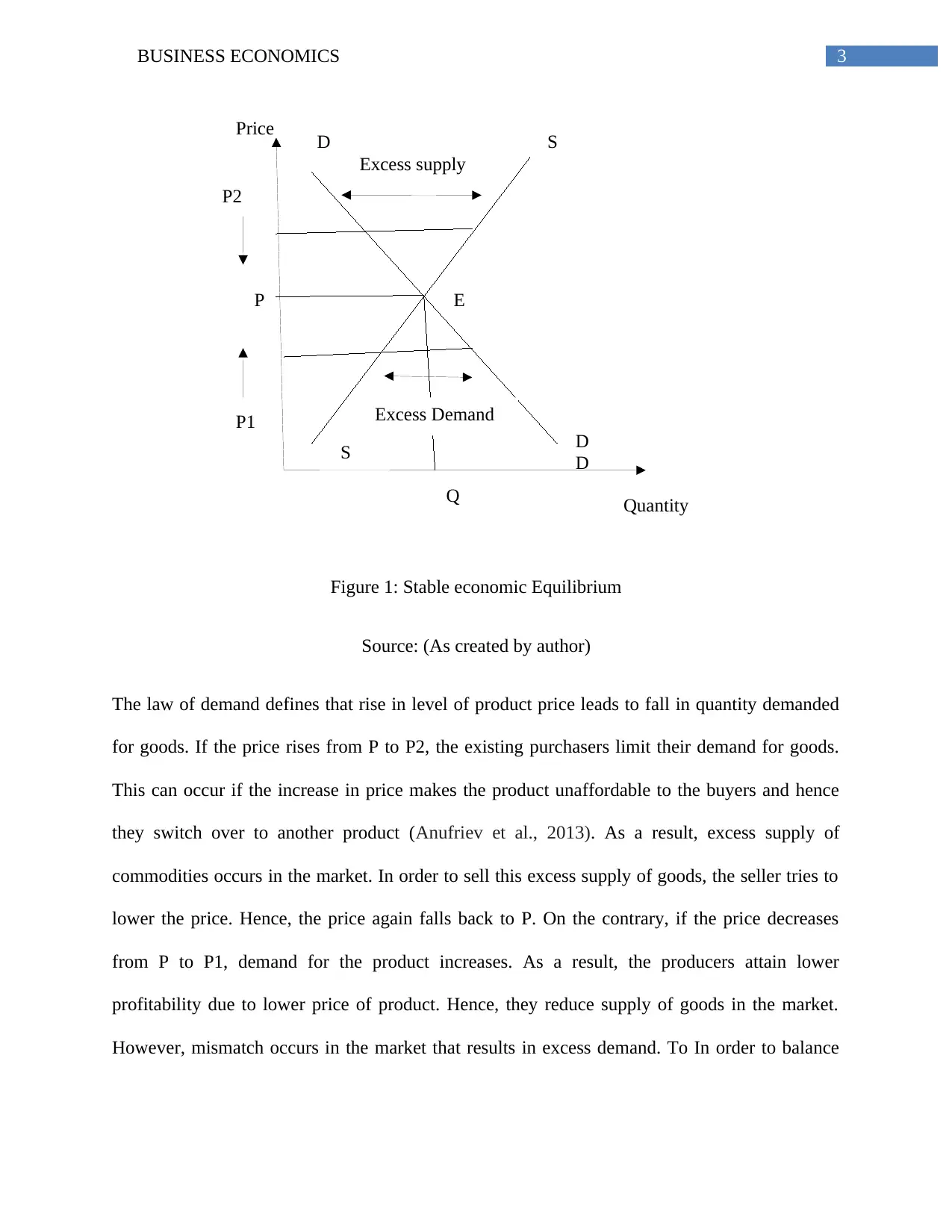
Quantity
Price
D
D
D S
S
EP
Q
P1
P2
Excess supply
Excess Demand
3BUSINESS ECONOMICS
Figure 1: Stable economic Equilibrium
Source: (As created by author)
The law of demand defines that rise in level of product price leads to fall in quantity demanded
for goods. If the price rises from P to P2, the existing purchasers limit their demand for goods.
This can occur if the increase in price makes the product unaffordable to the buyers and hence
they switch over to another product (Anufriev et al., 2013). As a result, excess supply of
commodities occurs in the market. In order to sell this excess supply of goods, the seller tries to
lower the price. Hence, the price again falls back to P. On the contrary, if the price decreases
from P to P1, demand for the product increases. As a result, the producers attain lower
profitability due to lower price of product. Hence, they reduce supply of goods in the market.
However, mismatch occurs in the market that results in excess demand. To In order to balance
Price
D
D
D S
S
EP
Q
P1
P2
Excess supply
Excess Demand
3BUSINESS ECONOMICS
Figure 1: Stable economic Equilibrium
Source: (As created by author)
The law of demand defines that rise in level of product price leads to fall in quantity demanded
for goods. If the price rises from P to P2, the existing purchasers limit their demand for goods.
This can occur if the increase in price makes the product unaffordable to the buyers and hence
they switch over to another product (Anufriev et al., 2013). As a result, excess supply of
commodities occurs in the market. In order to sell this excess supply of goods, the seller tries to
lower the price. Hence, the price again falls back to P. On the contrary, if the price decreases
from P to P1, demand for the product increases. As a result, the producers attain lower
profitability due to lower price of product. Hence, they reduce supply of goods in the market.
However, mismatch occurs in the market that results in excess demand. To In order to balance
Paraphrase This Document
Need a fresh take? Get an instant paraphrase of this document with our AI Paraphraser
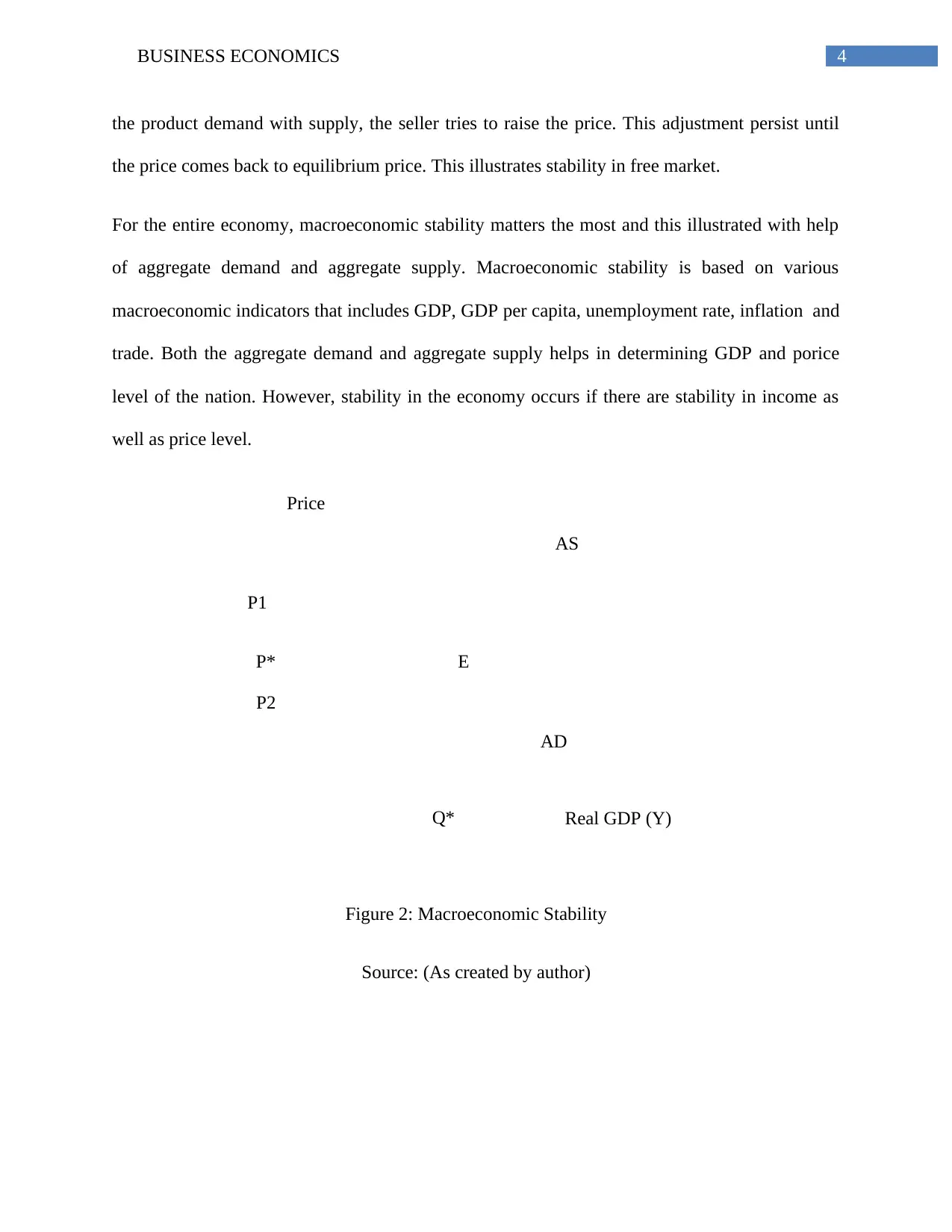
4BUSINESS ECONOMICS
AS
AD
Real GDP (Y)
Price
EP*
Q*
P1
P2
the product demand with supply, the seller tries to raise the price. This adjustment persist until
the price comes back to equilibrium price. This illustrates stability in free market.
For the entire economy, macroeconomic stability matters the most and this illustrated with help
of aggregate demand and aggregate supply. Macroeconomic stability is based on various
macroeconomic indicators that includes GDP, GDP per capita, unemployment rate, inflation and
trade. Both the aggregate demand and aggregate supply helps in determining GDP and porice
level of the nation. However, stability in the economy occurs if there are stability in income as
well as price level.
Figure 2: Macroeconomic Stability
Source: (As created by author)
AS
AD
Real GDP (Y)
Price
EP*
Q*
P1
P2
the product demand with supply, the seller tries to raise the price. This adjustment persist until
the price comes back to equilibrium price. This illustrates stability in free market.
For the entire economy, macroeconomic stability matters the most and this illustrated with help
of aggregate demand and aggregate supply. Macroeconomic stability is based on various
macroeconomic indicators that includes GDP, GDP per capita, unemployment rate, inflation and
trade. Both the aggregate demand and aggregate supply helps in determining GDP and porice
level of the nation. However, stability in the economy occurs if there are stability in income as
well as price level.
Figure 2: Macroeconomic Stability
Source: (As created by author)
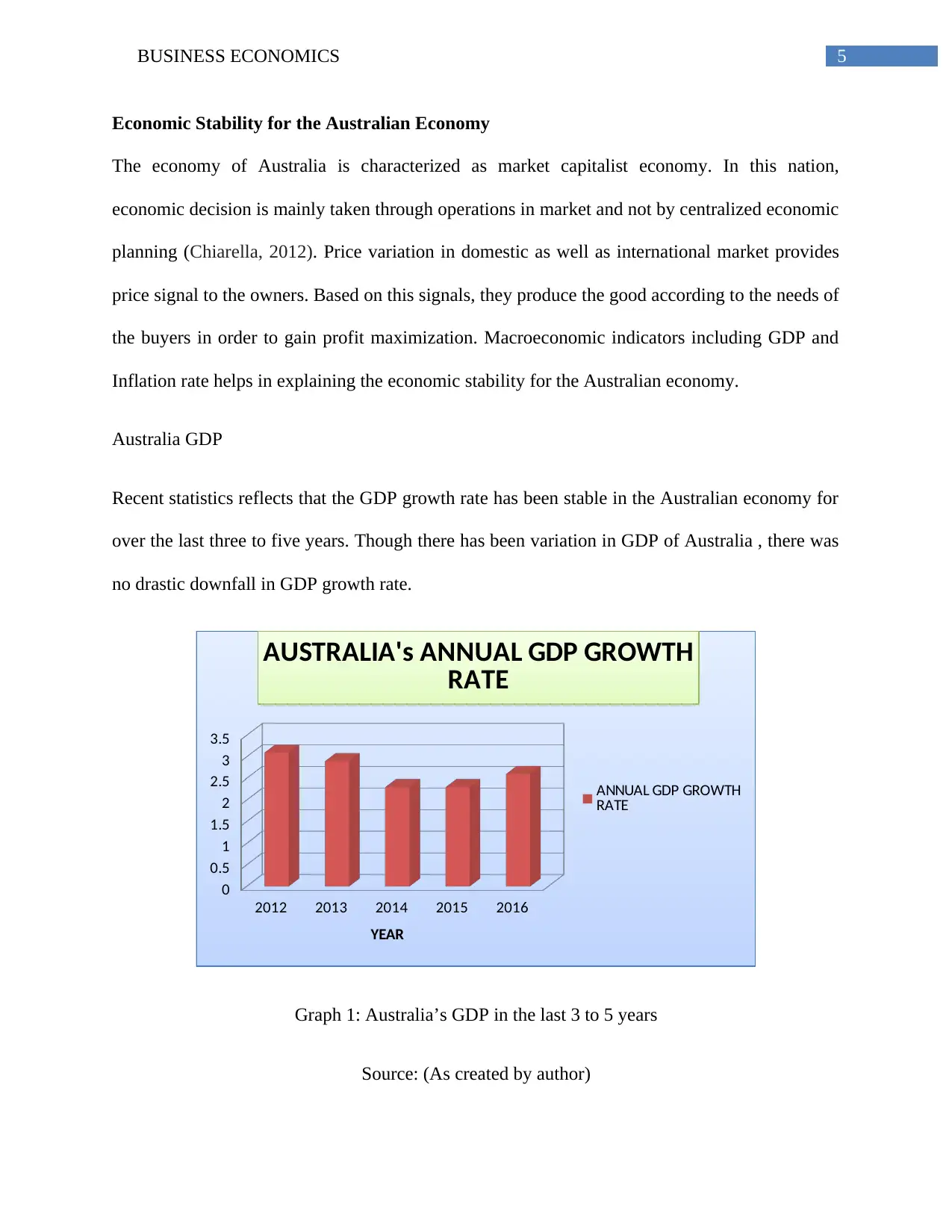
5BUSINESS ECONOMICS
Economic Stability for the Australian Economy
The economy of Australia is characterized as market capitalist economy. In this nation,
economic decision is mainly taken through operations in market and not by centralized economic
planning (Chiarella, 2012). Price variation in domestic as well as international market provides
price signal to the owners. Based on this signals, they produce the good according to the needs of
the buyers in order to gain profit maximization. Macroeconomic indicators including GDP and
Inflation rate helps in explaining the economic stability for the Australian economy.
Australia GDP
Recent statistics reflects that the GDP growth rate has been stable in the Australian economy for
over the last three to five years. Though there has been variation in GDP of Australia , there was
no drastic downfall in GDP growth rate.
2012 2013 2014 2015 2016
0
0.5
1
1.5
2
2.5
3
3.5
AUSTRALIA's ANNUAL GDP GROWTH
RATE
ANNUAL GDP GROWTH
RATE
YEAR
Graph 1: Australia’s GDP in the last 3 to 5 years
Source: (As created by author)
Economic Stability for the Australian Economy
The economy of Australia is characterized as market capitalist economy. In this nation,
economic decision is mainly taken through operations in market and not by centralized economic
planning (Chiarella, 2012). Price variation in domestic as well as international market provides
price signal to the owners. Based on this signals, they produce the good according to the needs of
the buyers in order to gain profit maximization. Macroeconomic indicators including GDP and
Inflation rate helps in explaining the economic stability for the Australian economy.
Australia GDP
Recent statistics reflects that the GDP growth rate has been stable in the Australian economy for
over the last three to five years. Though there has been variation in GDP of Australia , there was
no drastic downfall in GDP growth rate.
2012 2013 2014 2015 2016
0
0.5
1
1.5
2
2.5
3
3.5
AUSTRALIA's ANNUAL GDP GROWTH
RATE
ANNUAL GDP GROWTH
RATE
YEAR
Graph 1: Australia’s GDP in the last 3 to 5 years
Source: (As created by author)
⊘ This is a preview!⊘
Do you want full access?
Subscribe today to unlock all pages.

Trusted by 1+ million students worldwide
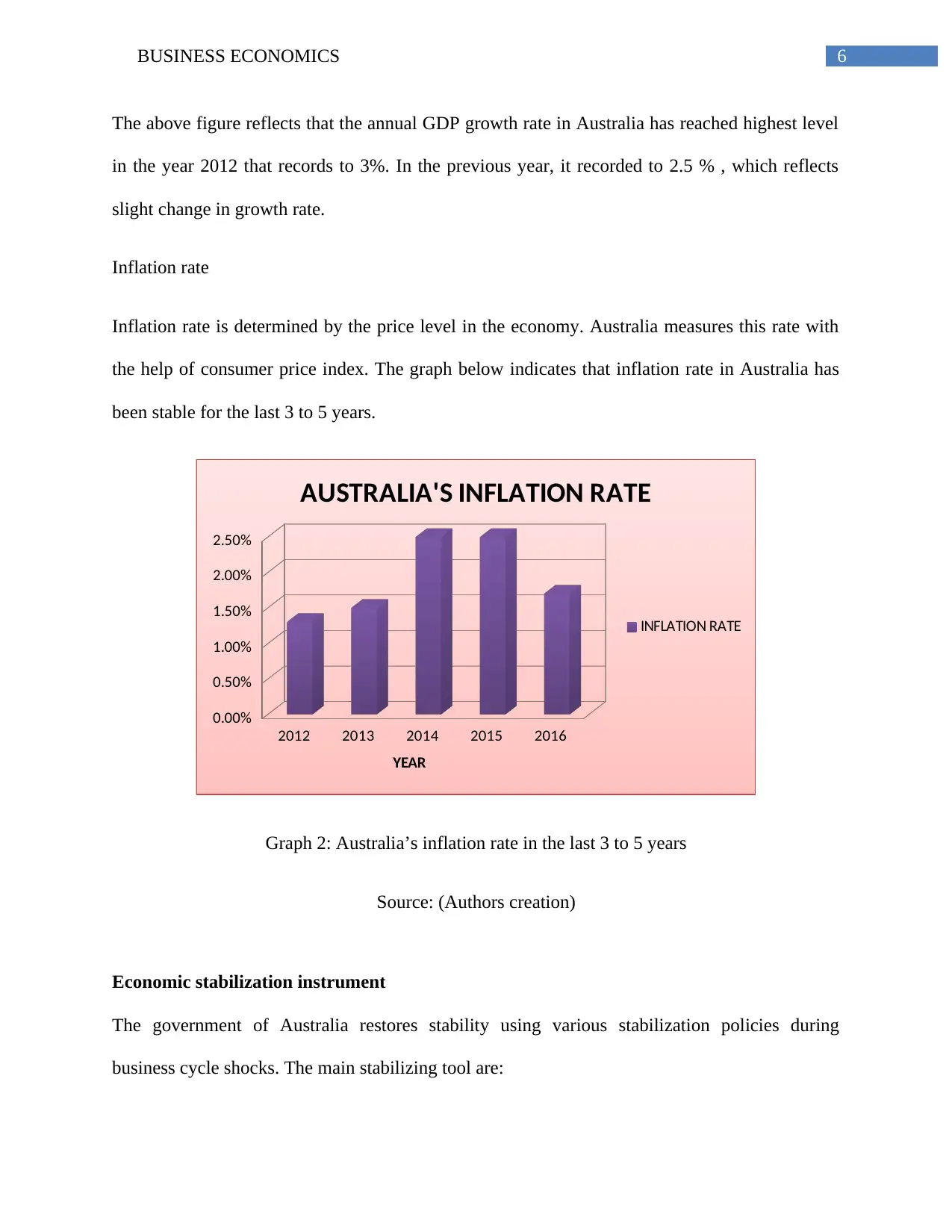
6BUSINESS ECONOMICS
The above figure reflects that the annual GDP growth rate in Australia has reached highest level
in the year 2012 that records to 3%. In the previous year, it recorded to 2.5 % , which reflects
slight change in growth rate.
Inflation rate
Inflation rate is determined by the price level in the economy. Australia measures this rate with
the help of consumer price index. The graph below indicates that inflation rate in Australia has
been stable for the last 3 to 5 years.
2012 2013 2014 2015 2016
0.00%
0.50%
1.00%
1.50%
2.00%
2.50%
AUSTRALIA'S INFLATION RATE
INFLATION RATE
YEAR
Graph 2: Australia’s inflation rate in the last 3 to 5 years
Source: (Authors creation)
Economic stabilization instrument
The government of Australia restores stability using various stabilization policies during
business cycle shocks. The main stabilizing tool are:
The above figure reflects that the annual GDP growth rate in Australia has reached highest level
in the year 2012 that records to 3%. In the previous year, it recorded to 2.5 % , which reflects
slight change in growth rate.
Inflation rate
Inflation rate is determined by the price level in the economy. Australia measures this rate with
the help of consumer price index. The graph below indicates that inflation rate in Australia has
been stable for the last 3 to 5 years.
2012 2013 2014 2015 2016
0.00%
0.50%
1.00%
1.50%
2.00%
2.50%
AUSTRALIA'S INFLATION RATE
INFLATION RATE
YEAR
Graph 2: Australia’s inflation rate in the last 3 to 5 years
Source: (Authors creation)
Economic stabilization instrument
The government of Australia restores stability using various stabilization policies during
business cycle shocks. The main stabilizing tool are:
Paraphrase This Document
Need a fresh take? Get an instant paraphrase of this document with our AI Paraphraser
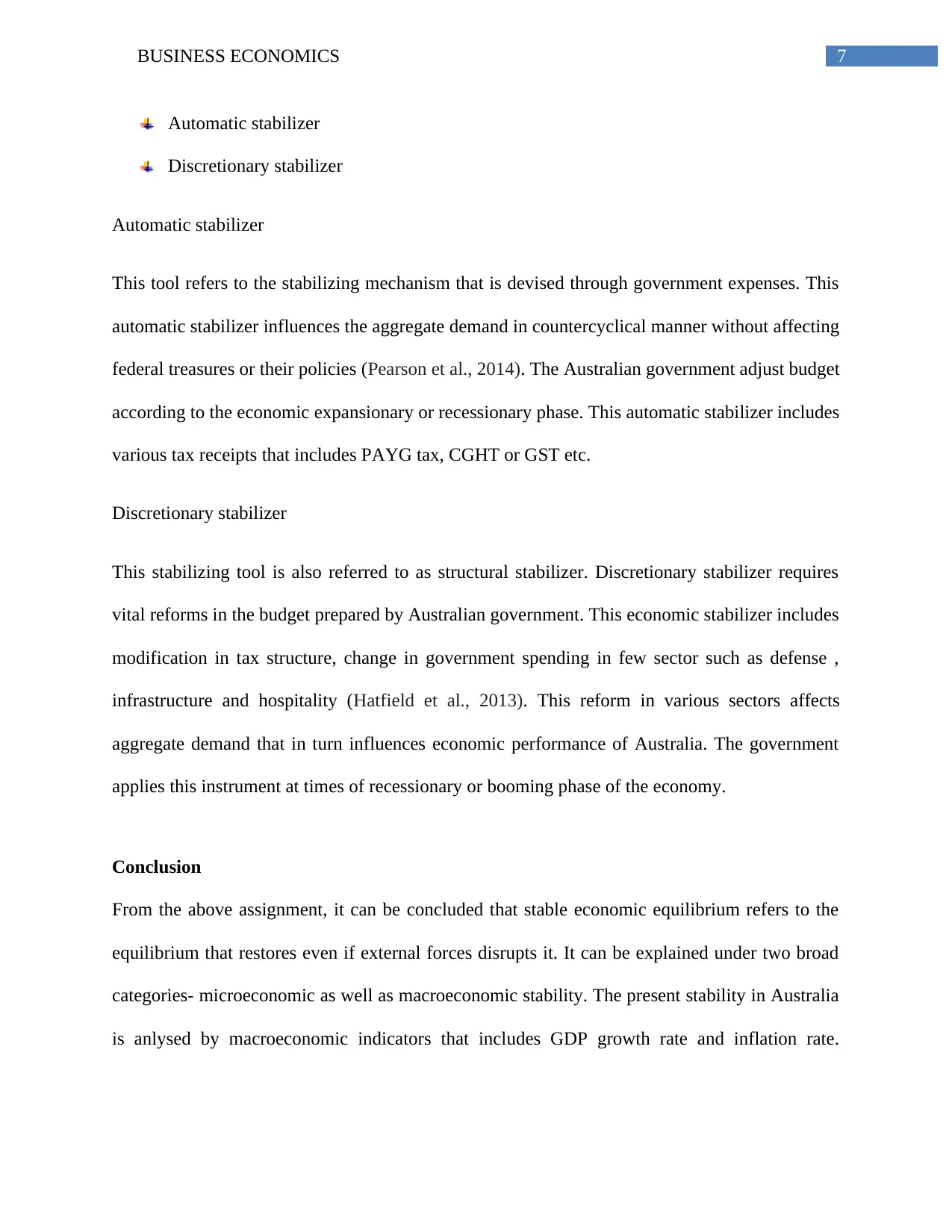
7BUSINESS ECONOMICS
Automatic stabilizer
Discretionary stabilizer
Automatic stabilizer
This tool refers to the stabilizing mechanism that is devised through government expenses. This
automatic stabilizer influences the aggregate demand in countercyclical manner without affecting
federal treasures or their policies (Pearson et al., 2014). The Australian government adjust budget
according to the economic expansionary or recessionary phase. This automatic stabilizer includes
various tax receipts that includes PAYG tax, CGHT or GST etc.
Discretionary stabilizer
This stabilizing tool is also referred to as structural stabilizer. Discretionary stabilizer requires
vital reforms in the budget prepared by Australian government. This economic stabilizer includes
modification in tax structure, change in government spending in few sector such as defense ,
infrastructure and hospitality (Hatfield et al., 2013). This reform in various sectors affects
aggregate demand that in turn influences economic performance of Australia. The government
applies this instrument at times of recessionary or booming phase of the economy.
Conclusion
From the above assignment, it can be concluded that stable economic equilibrium refers to the
equilibrium that restores even if external forces disrupts it. It can be explained under two broad
categories- microeconomic as well as macroeconomic stability. The present stability in Australia
is anlysed by macroeconomic indicators that includes GDP growth rate and inflation rate.
Automatic stabilizer
Discretionary stabilizer
Automatic stabilizer
This tool refers to the stabilizing mechanism that is devised through government expenses. This
automatic stabilizer influences the aggregate demand in countercyclical manner without affecting
federal treasures or their policies (Pearson et al., 2014). The Australian government adjust budget
according to the economic expansionary or recessionary phase. This automatic stabilizer includes
various tax receipts that includes PAYG tax, CGHT or GST etc.
Discretionary stabilizer
This stabilizing tool is also referred to as structural stabilizer. Discretionary stabilizer requires
vital reforms in the budget prepared by Australian government. This economic stabilizer includes
modification in tax structure, change in government spending in few sector such as defense ,
infrastructure and hospitality (Hatfield et al., 2013). This reform in various sectors affects
aggregate demand that in turn influences economic performance of Australia. The government
applies this instrument at times of recessionary or booming phase of the economy.
Conclusion
From the above assignment, it can be concluded that stable economic equilibrium refers to the
equilibrium that restores even if external forces disrupts it. It can be explained under two broad
categories- microeconomic as well as macroeconomic stability. The present stability in Australia
is anlysed by macroeconomic indicators that includes GDP growth rate and inflation rate.
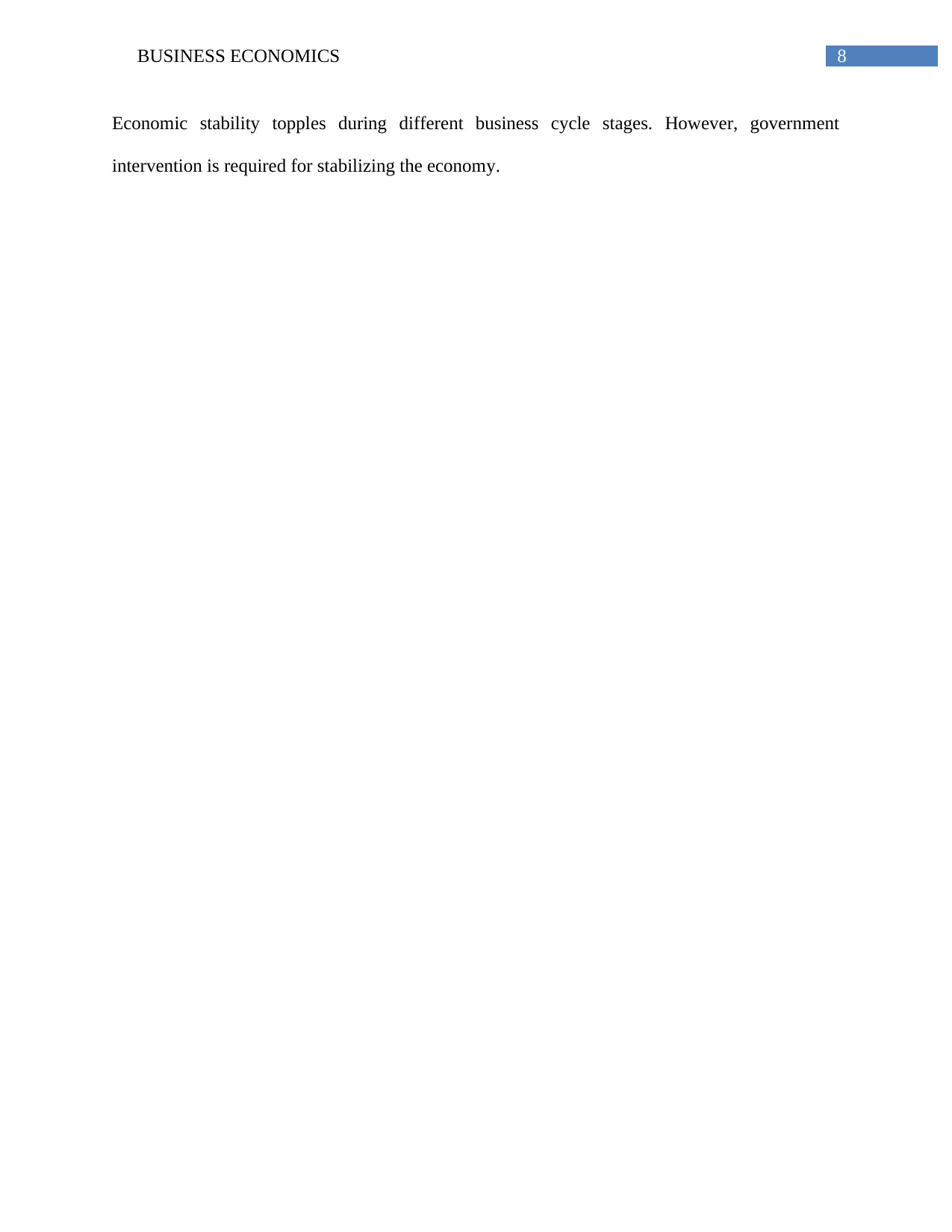
8BUSINESS ECONOMICS
Economic stability topples during different business cycle stages. However, government
intervention is required for stabilizing the economy.
Economic stability topples during different business cycle stages. However, government
intervention is required for stabilizing the economy.
⊘ This is a preview!⊘
Do you want full access?
Subscribe today to unlock all pages.

Trusted by 1+ million students worldwide
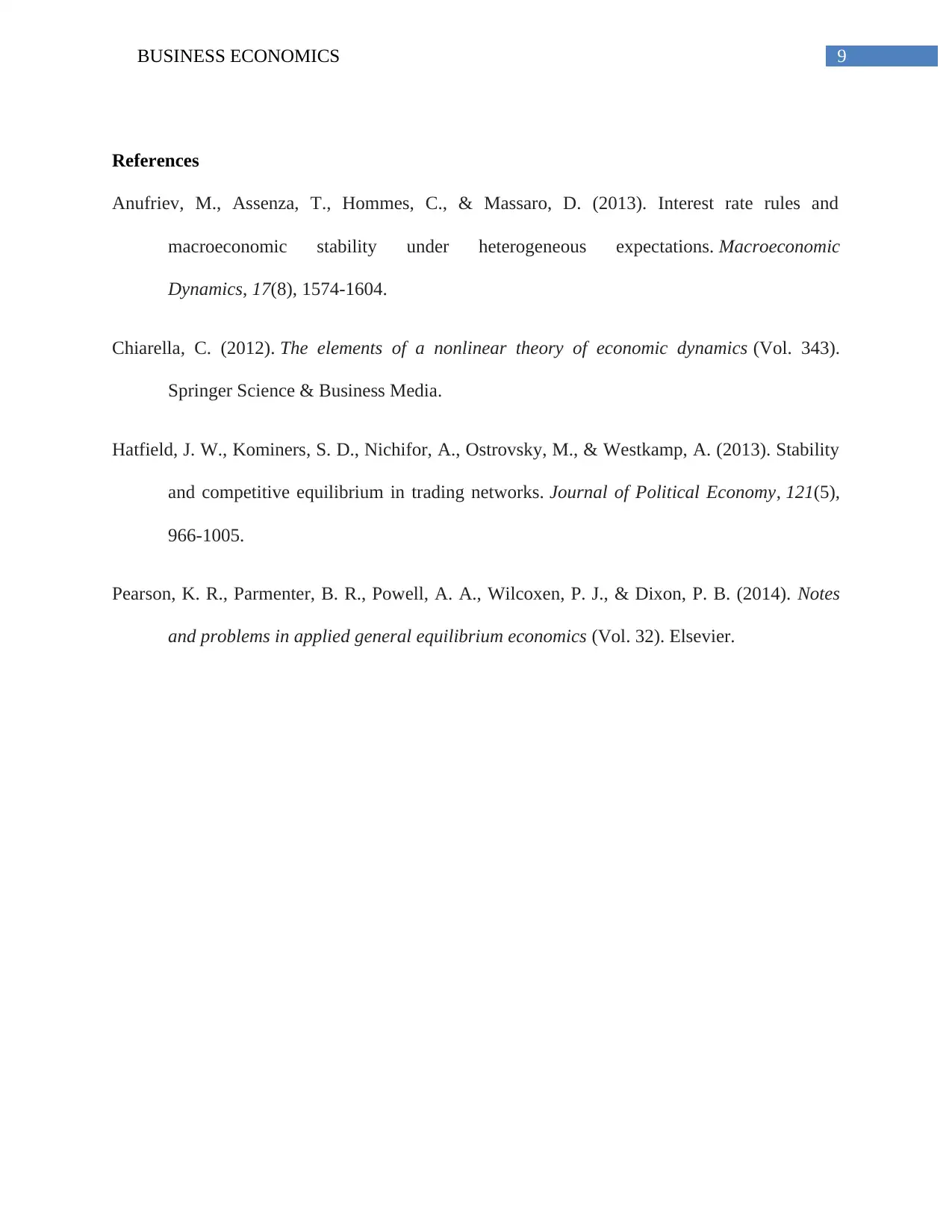
9BUSINESS ECONOMICS
References
Anufriev, M., Assenza, T., Hommes, C., & Massaro, D. (2013). Interest rate rules and
macroeconomic stability under heterogeneous expectations. Macroeconomic
Dynamics, 17(8), 1574-1604.
Chiarella, C. (2012). The elements of a nonlinear theory of economic dynamics (Vol. 343).
Springer Science & Business Media.
Hatfield, J. W., Kominers, S. D., Nichifor, A., Ostrovsky, M., & Westkamp, A. (2013). Stability
and competitive equilibrium in trading networks. Journal of Political Economy, 121(5),
966-1005.
Pearson, K. R., Parmenter, B. R., Powell, A. A., Wilcoxen, P. J., & Dixon, P. B. (2014). Notes
and problems in applied general equilibrium economics (Vol. 32). Elsevier.
References
Anufriev, M., Assenza, T., Hommes, C., & Massaro, D. (2013). Interest rate rules and
macroeconomic stability under heterogeneous expectations. Macroeconomic
Dynamics, 17(8), 1574-1604.
Chiarella, C. (2012). The elements of a nonlinear theory of economic dynamics (Vol. 343).
Springer Science & Business Media.
Hatfield, J. W., Kominers, S. D., Nichifor, A., Ostrovsky, M., & Westkamp, A. (2013). Stability
and competitive equilibrium in trading networks. Journal of Political Economy, 121(5),
966-1005.
Pearson, K. R., Parmenter, B. R., Powell, A. A., Wilcoxen, P. J., & Dixon, P. B. (2014). Notes
and problems in applied general equilibrium economics (Vol. 32). Elsevier.
1 out of 10
Related Documents
Your All-in-One AI-Powered Toolkit for Academic Success.
+13062052269
info@desklib.com
Available 24*7 on WhatsApp / Email
![[object Object]](/_next/static/media/star-bottom.7253800d.svg)
Unlock your academic potential
Copyright © 2020–2025 A2Z Services. All Rights Reserved. Developed and managed by ZUCOL.





